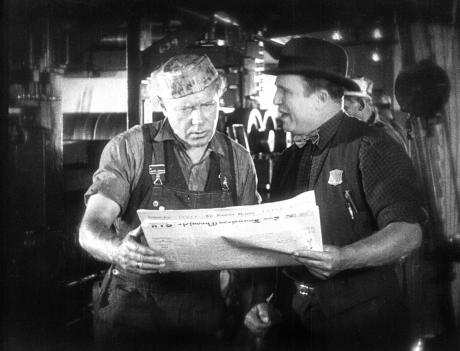
Emory Johnson/FBO, 1925. Director: Emory Johnson. Scenario: Emilie Johnson. Camera: Gilbert Warrenton, Frank Evans. Cast: Ralph Lewis, Frances Teague, Rex Lease, Lou Payne, Tom O’Brien, Billy Bakewell.
There are getting to be a number of high quality classic-film festivals around the world, and it’s intriguing to observe that each of them has established a unique, distinctive identity of its own. The San Francisco Silent Film Festival is a striking example. Launched in 1996, this festival has actively evolved over the years since then. Initially it was framed as a venue for the textbook classics of the silent screen, offered in sumptuously beautiful presentations for an audience that was, at first, largely unfamiliar with the silents. Thanks to this wise strategy, the SFSFF has built a large, enthusiastic local audience for silent film, and has tended toward increasingly adventurous programming of rarities and obscurities—still presented with all the polish and showmanship of the landmark titles, and still well attended by appreciative audiences.
As if that were not enough, the SFSFF began in 2012 to branch out into the world of film restoration. Previously “lost” silents have been brought back to life by the careful attentions of the Festival’s principals, working in collaboration with established archives and laboratories. Some of those restored films have been issued in Blu-Ray editions by Flicker Alley, and I’ve featured some of them in earlier editions of this column.
But even apart from the silents committed to disc, there are others that the Festival generously shares in the form of streaming video on its website. These other films may be more “hidden,” but the viewer who overlooks them is missing a treat. A notable example is The Last Edition. This long-forgotten newspaper drama was not known to survive until a nitrate 35mm print, with Dutch titles, turned up in the collection of the EYE Film Instituut in Amsterdam, deposited there by the late collector Jan Zaalberg. Filmed largely in authentic locations in San Francisco in 1925, The Last Edition exercised an obvious appeal for the directors of the San Francisco festival, who partnered with the EYE technicians to reconstruct it with its English titles and its original tinting and toning.
I love a good newspaper movie, and this one is a beauty. It’s a solid, fast-moving melodrama, replete with crusading reporters, a tough editor, late-breaking headlines, exposure of political corruption, and a chase through city streets thrown in for good measure. All of this would be appealing enough in itself, but this film offers an extra dimension of historical fascination: the newspaper in the story is no generic fictional paper, but the San Francisco Chronicle itself. In 1925 the Chronicle was already a venerable institution of sixty years’ standing, and for this film it’s clear that the filmmakers were given special access by the real-life Chronicle. As the story plays out we get generous views of the paper’s offices, its typesetting and press rooms, and the circulation trucks that distribute the papers on the street.
The Last Edition is an independent production, made without the luxury of major stars. For the dedicated silent-film enthusiast, however, this cast is exciting in its own right. The top-billed star is Ralph Lewis—not exactly a household name, but a respected actor who had won his spurs in D.W. Griffith’s stock company and had gone on to a busy career as a character player. Here, as a veteran pressman passed over for an expected promotion, he brings dignity and intensity to the story’s pivotal role. Rex Lease, on the threshold of a long career in action films (primarily Westerns), is dynamic as an ambitious young reporter. Tom O’Brien, fresh from his turn as the tough Irish doughboy in Vidor’s The Big Parade, is crude and loutish as the new foreman of the press room. Louis Payne contributes a colorful vignette as the irascible publisher, unwilling to brook any disagreement from his staff, yet disgusted with his attendant cadre of yes-men. And the film offers two notable cameo appearances: a brief glimpse of director Emory Johnson—years before Hitchcock started making his own famous cameos—and a more extended appearance by Chief Daniel J. O’Brien, playing himself: the Chief of Police of San Francisco. In addition to lending the story an added note of authenticity, Chief O’Brien was the father of George O’Brien, who was currently enjoying his first flush of top stardom in the movies. In a quiet gesture of family pride, Chief O’Brien plays his brief scene in an office set decorated with publicity photos of his famous son.
Emory Johnson, an actor-turned-independent-producer, was responsible for this and a string of other Bay Area-based features during the mid-1920s. Working (for the most part) far from the established production centers in Hollywood and on a modest budget, Johnson here demonstrates resourcefulness and a strong cinematic sensibility. As Lou Payne struggles to write an editorial, a closeup displays his frustration as tiny demons, perched on his shoulders, torment him. In a well-staged action sequence, Rex Lease as the overzealous reporter pursues a suspected bootlegger through the city, at one point cornering his quarry in a freight elevator as the camera captures the action from dramatic high and low angles.
In the SFSFF presentation, all of this is accompanied by a lively piano score by Stephen Horne. And, compounding this banquet of riches, we also get links to additional delicacies—including the film’s original trailer, which the team discovered in the collections of the Library of Congress, and a gallery of San Francisco and Los Angeles location IDs provided by movie-location guru John Bengtson. In short, the Festival’s directors have not only rescued an unsuspected gem from oblivion, but have gifted it to us in a lavish package. We owe them our thanks, and not for the first time.

